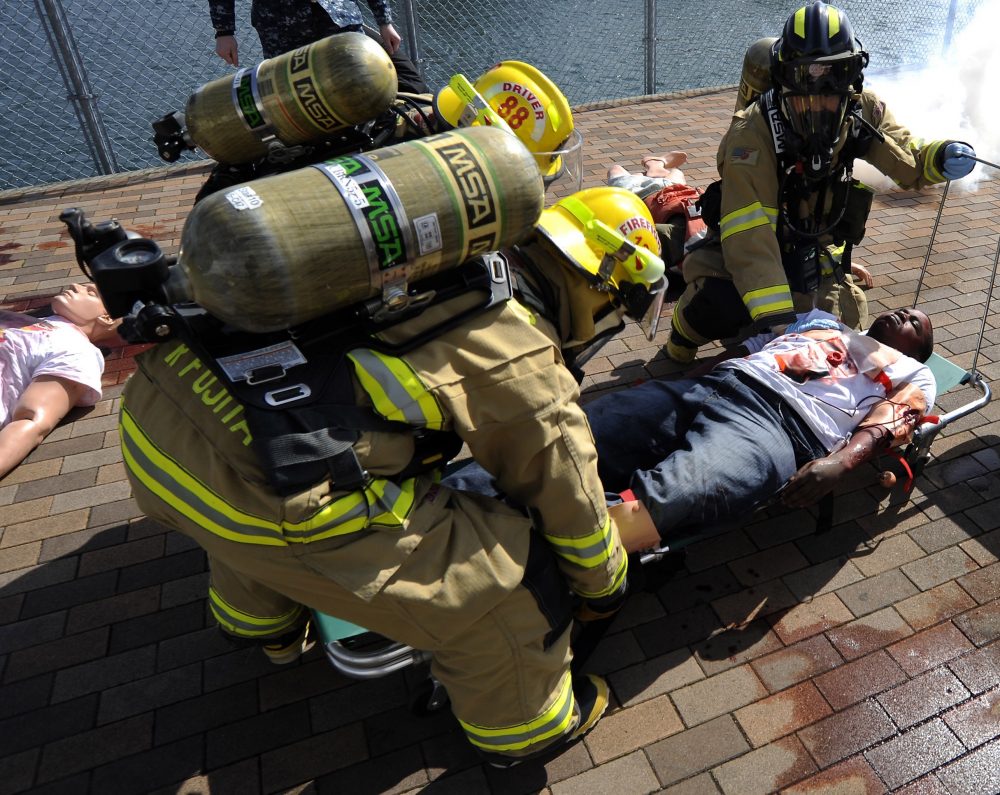Firefighters transport “patient” to ambulance during anti-terrorism exercise. Average response time for BLS ambulance in the U.S. is seven minutes. Someone who is severely bleeding can bleed to death in as little as five minutes. U.S. Navy photo by Mass Communication Specialist Richard Doolin.
In an unpredictable world, medical emergencies can arise at any moment. Being prepared can make all the difference. This is where first aid kits and trauma kits, along with basic emergency medical training come into play. They serve as the first line of defense, bridging the gap between the onset of an emergency and the arrival of professional medical help. Understanding their importance and being prepared for medical emergencies is not just advisable, it is essential. Emergency medical response is in your hands.
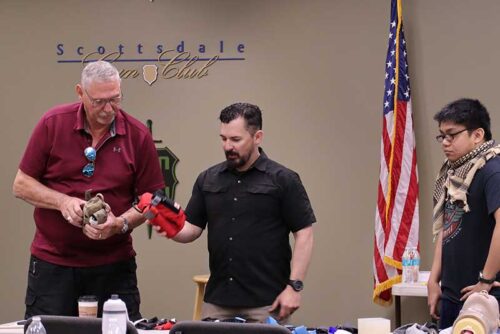
First Aid Kits and Trauma Kits
A first aid kit and a trauma kit are both designed to provide emergency care. However, they have different purposes and contents. It is important to understand the difference. A first aid kit is designed for treating minor injuries, such as cuts, scrapes, burns, sprains, and stings, although a very comprehensive first aid kit can have some lifesaving trauma kit components. A trauma kit is designed for treating life-threatening injuries, such as severe bleeding, penetrating chest wounds, and shock. Some comprehensive trauma kits may also contain some first aid components.
A combination kit can help treat both minor and major injuries, but it needs to be well organized. You don’t want to have to dig through components to locate what you need when dealing with a life-threatening injury. This concept is best summed up by a motto of Dark Angel Medical: “Simplicity Under Stress.” Also, with more components comes larger size.
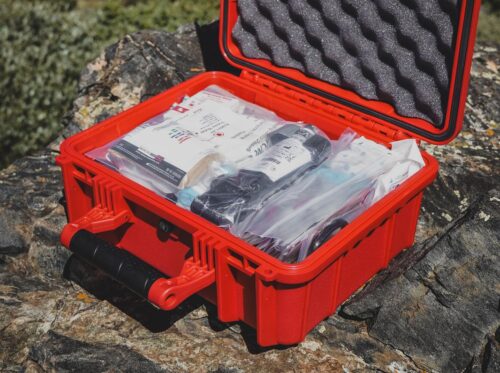
A first aid kit and a trauma kit are both important to have in case of an emergency. However, they are not interchangeable. Each fulfills a different role. A first aid kit can help with minor injuries, but it cannot save a life in a critical situation. A trauma kit can help with life-threatening injuries, but it is not designed to treat minor injuries. It is advisable to have both types of kits available and accessible in case of an emergency. But if you opt to carry only one type with you, carry a trauma kit. Minor injuries can wait, life threatening injuries cannot.
Everyone should carry a trauma kit or, at the very least, a tourniquet (along with nitrile gloves for protection from blood-borne pathogens). It’s our duty as responsible citizens. We’re not prepared if we don’t. No matter how fast the response of emergency medical services (EMS), bystanders will always be first on the scene. And in an active shooter or terrorist incident, emergency personnel won’t reach victims until the threat has been neutralized. The simple fact is that you’re your own first responder. You need be prepared and able to treat life-threatening injuries. Your goal is to stabilize the patient until EMS arrives. Time is life.
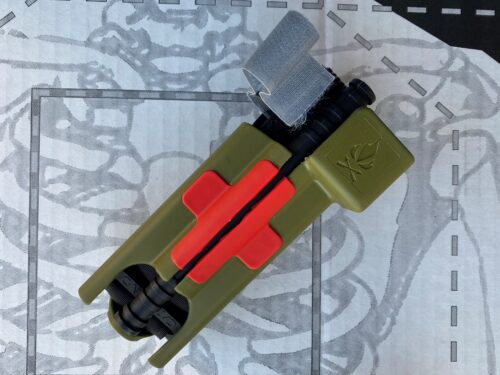
The term “IFAK” has made its way into civilian jargon and has led to some confusion. IFAK is the acronym for individual first aid kit. It is a military term that describes a specialized medical kit designed to manage traumatic injuries in combat situations. An IFAK is not the same as a regular first aid kit, which is meant for minor injuries. An IFAK is meant to be carried by members of the military in combat and during training for use on themselves or their teammates in case of a traumatic injury. An IFAK is not a substitute for professional medical care, but it can save lives until help arrives.
A trauma kit and an IFAK are essentially the same thing, as they both contain items that can help save lives in emergency situations. Although there are some basics, the components vary, depending on the intended use and the level of training of the person who carries it.
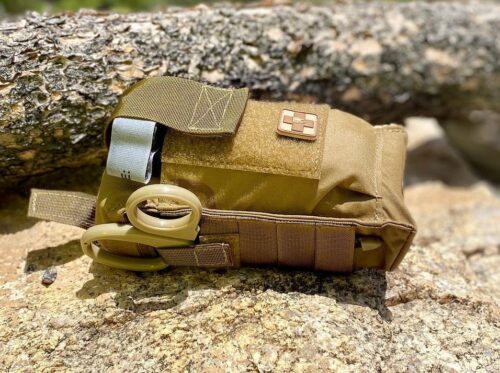
EDC Trauma Kit
Selecting an everyday carry (EDC) trauma kit involves making compromises without neglecting essentials. It needs to be lightweight, compact, and easy to use. It needs to be convenient to carry on your person. You want everything you need but nothing you don’t. Having a trauma kit in your vehicle or range bag, while an excellent idea, isn’t enough if you can’t reach it immediately. When you need a trauma kit, you need it quickly. You may have the time or the ability to retrieve it from your vehicle or range bag.
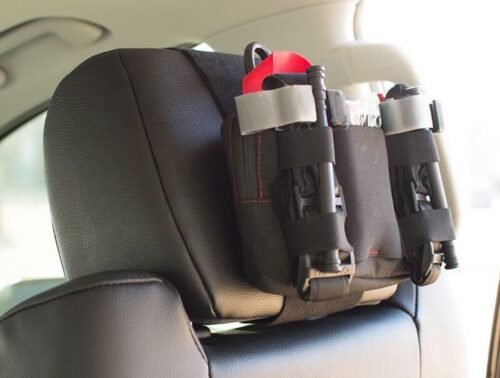
An EDC trauma kit should include essential lifesaving medical supplies that are easy to carry and can be quickly deployed in emergency situations. Although size does matter when it comes to EDC, you need to be able to “stop the bleeding and start the breathing.” The following are recommended at a bare minimum:
Tourniquet(s)
Hemostatic Gauze
Pressure Bandage
Chest Seals
Nitrile Gloves
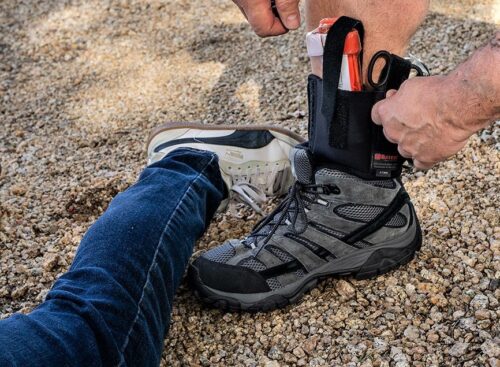
Emergency Medical Training
Having the necessary tools is only part of the equation. Equipment is only as good as your training. The time to learn to use it is not in an emergency.
Basic emergency medical training should cover the entire spectrum of lifesaving skills. And like shooting, they’re perishable skills. We all know the importance of regular firearms training, but medical training is often neglected. You are more likely to need to use medical skills than you are your firearm.
Medical skills are essential for dealing with emergencies that may arise in everyday life. Emergencies can happen anytime, anywhere, and to anyone. They can be caused by accidents, injuries, illnesses, natural disasters, or violence. Some emergencies are life-threatening and require immediate action to save lives and prevent further harm. Others are less urgent but still need proper care and attention to avoid complications or infections.Basic emergency medical training is available from a variety of sources.
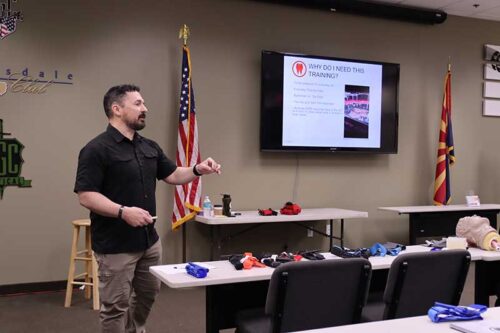
Having medical skills can help you to recognize the signs and symptoms of an emergency, assess the situation and the needs of the affected person, provide first aid or basic life support, and call for professional help if needed. By having medical skills, you can be more confident and prepared to handle any emergency that may come your way. You don’t need to be a doctor or a nurse to learn these skills. Anyone can benefit from having some basic medical knowledge and skills that can make a difference in an emergency situation. Here are a few sources of training:
Dark Angel Medical Direct Action Response Training (D.A.R.T)
The Direct Action Response Training (D.A.R.T.) course by Dark Angel Medical is a comprehensive program designed to bridge the gap between military self-aid/buddy care training and civilian EMS training. This course is particularly beneficial for those with little to no medical training or background.
The D.A.R.T. course is a 2-day program with a total of 16 hours of classroom work, including slide presentations, videos, question and answer sessions, and hands-on practical skills application³. It covers a wide range of topics such as physiological and psychological reactions to environmental stress, basic anatomy and physiology of life-sustaining systems, hemorrhage control, airway management, and the application of bandages, hemostatic agents, and tourniquets.
The course also prepares students for active shooter situations, teaching them the proper use of cover and how to recover casualties in such scenarios. All participants receive BCON (Bleeding Control) certification from the American College of Surgeons. It is approved for 16 hours of continuing education units for Nationally Registered EMT’s and Paramedics. The course emphasizes the principle of “Simplicity Under Stress”, providing students with critical, need-to-know information that can be utilized in a myriad of situations.
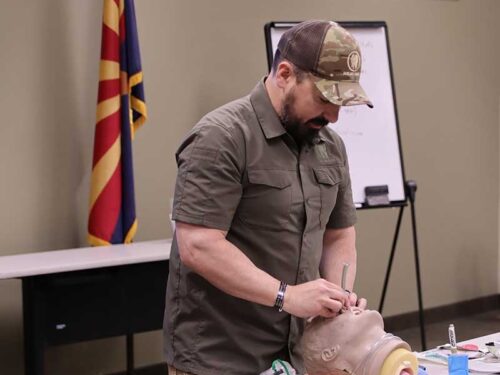
NAEMT First on the Scene (FOTS)
The First on the Scene (FOTS) training is a program developed by the National Association of Emergency Medical Technicians (NAEMT) and the International Association of Fire Chiefs (IAFC). It is designed to teach the general public basic emergency response to life-threatening emergencies until EMS arrives on the scene.
The course covers a range of topics including activating the 911 system, hands-only CPR and AED, administering naloxone, administering epinephrine, responding to life-threatening bleeding, penetrating chest trauma, moving patients to safety, and positioning injured patients.
All NAEMT training centers are approved to teach FOTS courses. Certified EMS instructors at the EMT, AEMT or Paramedic levels, currently certified fire instructors, or NAEMT-approved instructors may conduct FOTS courses.
Red Cross Emergency Medical Response (EMR)
The American Red Cross offers a training program based on the national EMS educational standards for an Emergency Medical Responder. The Emergency Medical Response (EMR) course is a dynamic 56-hour course featuring lecture, video, simulated emergency situations, discussion, and hands-on skill practice based on the national EMS curriculum requirements and educational standards. While EMR does not provide state licensure or certification as an Emergency Medical Responder, it provides training similar to the training EMS professionals receive. The Red Cross also offers basic first aid classes and CPR/AED training.
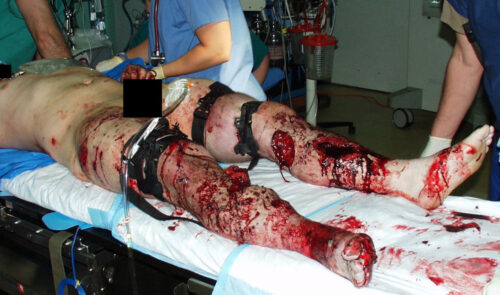
Fieldcraft Survival Emergency Trauma Treatment Course
The Emergency Trauma Treatment Course offered by Fieldcraft Survival is a one-day course designed to equip individuals with the knowledge and skills necessary to respond confidently in emergencies. This course is the first step in the Fieldcraft Medical Series, where instructors teach participants to master the fundamentals of treating trauma and managing the chaos that often accompanies an emergency.
Participants learn best practices such as sizing up a scene, conducting a patient assessment, and communicating with first responders. They also learn to identify an array of medical devices in their trauma kits and understand how, when, and why to utilize them through hands-on practice. This course not only equips individuals with life-saving skills but also builds confidence in their ability to be their own first responder.
Fieldcraft Survival also offers free first aid and CPR training as part of its Responsible Citizen Program of courses, as well as online training courses.
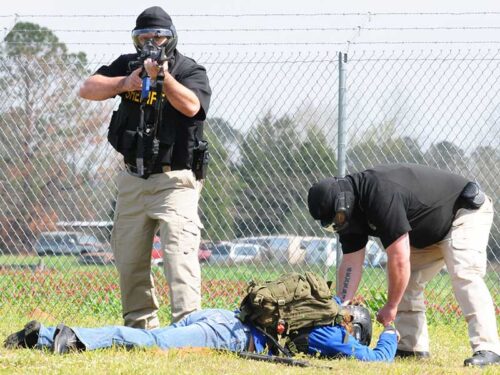
U.S. Concealed Carry Association (USCCA) Emergency First Aid Fundamentals
The U.S. Concealed Carry Association (USCCA) offers a variety of training courses, including medical training courses, One of the key courses is the Emergency First Aid Fundamentals. This course is designed to equip individuals with basic first aid and lifesaving techniques to be used in the event of a medical emergency.
The course covers how to properly assess a patient and deal with significant issues such as venous and arterial bleeding, compromised airway, head, chest, and spinal injuries, broken bones, burns, heart attacks, seizures, strokes, and more. Students also learn how to build their own First Aid/Trauma Kit.
The goal of the Emergency First Aid Fundamentals course is to help individuals gain the knowledge, confidence, and competence needed to deal with dozens of medical and traumatic emergencies. The course also includes simulated real-life scenarios, which give students a chance to overcome their body and mind’s natural reaction to a traumatic scene.
In addition to the Emergency First Aid Fundamentals, USCCA also offers other courses such as the Concealed Carry and Home Defense Course, The Legal Use of Force, Violent Encounters and the Aftermath, Traumatic Emergencies, and Medical Emergencies. These courses vary in length and material, providing a comprehensive understanding of different aspects of personal safety.
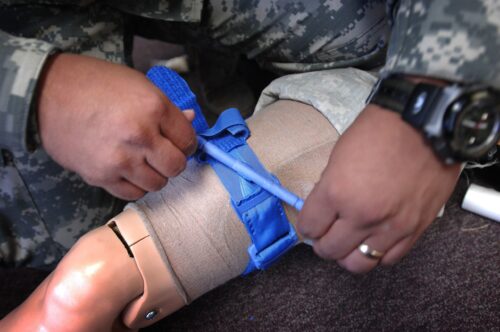
STOP THE BLEED
The American College of Surgeons’ STOP THE BLEED® program is also an outstanding training resource. Hemorrhage secondary to traumatic injury is the leading cause of death of Americans from one to 46 years of age. Up to half of the deaths resulting from hemorrhage occur before reaching definitive care.1 According to published research, EMS units average seven minutes from the time of a 911 call to arrival on scene. In rural areas, the median time for EMS personnel to arrive is more than 14 minutes, and almost 10% of the cases have to wait for nearly 30 minutes.2 Someone who is severely bleeding can bleed to death in as little as five minutes.3 It is the most preventable cause of death in compressible injuries. The only thing more tragic than a life lost is a life lost that could have been saved.
The STOP THE BLEED program is a national initiative that aims to train people in basic bleeding control techniques and equip public venues with bleeding control kits. The program is based on the lifesaving lessons learned from military medicine and research. By taking a STOP THE BLEED course, you can learn how to use your hands, dressings, and tourniquets to stop life-threatening bleeding in an emergency situation. Since its inception, the STOP THE BLEED campaign has trained over 2.6 million people worldwide on how to control serious bleeding.
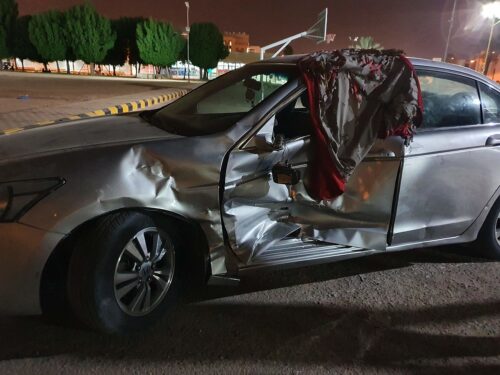
Deployed Medicine
Although not a substitute for hands-on training under the eyes of a watchful instructor, the online learning platform Deployed Medicine is also a great training resource. Used by the Defense Health Agency (DHA) “to trial new innovative learning models aimed at improving readiness and performance of deployed military medical personnel,” It’s free and you don’t have to be a member of the military to take advantage of it. I suggest that you check it out.
American Heart Association
According to the American Heart Association, less than half of those who have a cardiac arrest outside of a hospital receive lifesaving help of any kind. And about 90% of them die.4 Cardiopulmonary Resuscitation (CPR) and Automated External Defibrillator (AED) training are crucial skills that everyone should acquire. These life-saving techniques can be the difference between life and death in cardiac emergency situations where every second counts. CPR can keep oxygen flowing to the brain and other vital organs until medical help arrives. An AED is a device that analyzes the heart’s rhythm when its pads are attached to a person’s chest and delivers a shock, if needed, that allows the heart to reset its natural pacemaker and begin beating normally again. Public access AEDs can now be found in airports, community centers, schools, government buildings, hospitals, and other public locations, although it is not nearly enough locations.The American Heart Association offers CPR and AED training through training centers.
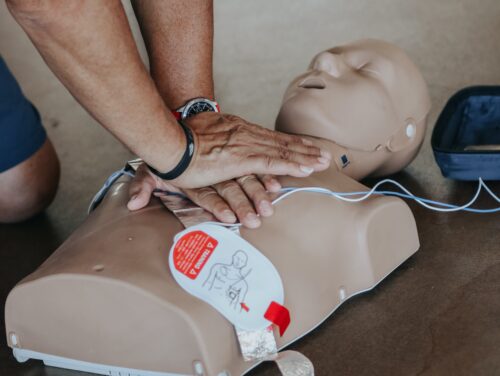
Sources:
Dark Angel Medical
DarkAngelMedical.com
National Association of Emergency Medical Technicians
NAEMT.org
American Red Cross
RedCross.org
Fieldcraft Survival
FieldcraftSurvival.com
U.S. Concealed Carry Association (USCCA)
USConcealedCarry.com
STOP THE BLEED
STOPTHEBLEED.org
Deployed Medicine
DeployedMedicine.com
American Heart Association
Heart.org
Galco Holsters
GalcoHolsters.com
Endnotes
1. Donley ER, Munakomi S, Loyd JW. Hemorrhage Control. 2022 Nov 16. In: StatPearls [Internet]. Treasure Island (FL): StatPearls Publishing; 2022 Jan–. PMID: 30571014.
2. Mell HK, Mumma SN, Hiestand B, Carr BG, Holland T, Stopyra J. Emergency Medical Services Response Times in Rural, Suburban, and Urban Areas. JAMA Surg. 2017;152(10):983–984. doi:10.1001/jamasurg.2017.2230.
3.. American College of Surgeons Committee on Trauma.(n.d.) “Learn More.” STOP THE BLEED®, https://www.stopthebleed.org/learn-more/, Retrieved 11 November 2023.
4. American Heart Association. (n.d.). What is an Automated External Defibrillator? https://www.heart.org/-/media/files/health-topics/answers-by-heart/what-is-an-aed.pdf, Retrieved 11 November 2023.
*The views and opinions expressed on this website are solely those of the original authors and contributors. These views and opinions do not necessarily represent those of Spotter Up Magazine, the administrative staff, and/or any/all contributors to this site.
